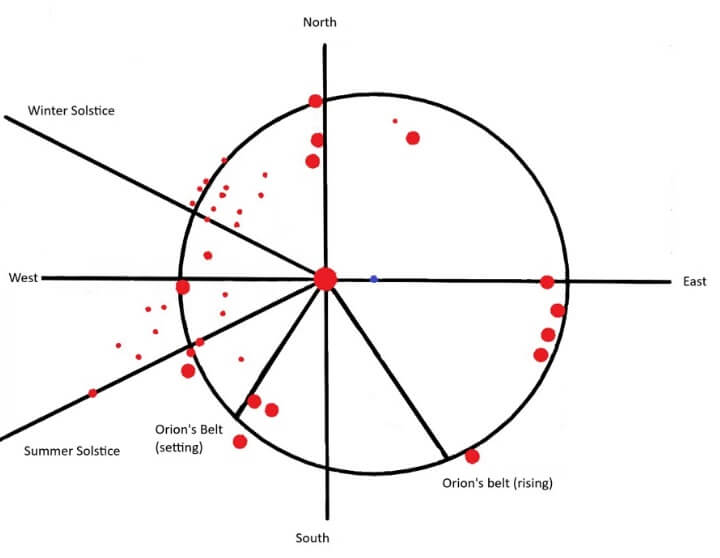Forced to make an unplanned landing, his plane crashed into a mountainside. Heine was miraculously unhurt, and exited the plane to see three monolithic dolomite stones before him. These huge stones, weighing around 5 metric tonnes (5.5 US tons) each, were sticking out of the ground. And next to them was a giant circle made out of stone.
The site is in an extremely remote location, with access restricted to a few rough roads filled with dirt. If the pilot had not crash landed and made the discovery, it is likely it would remain hidden to this day.
But what Heine had found was truly extraordinary. The megalithic site appeared to be a truly ancient stone calendar, and in recognition of this extreme age was given the name “Adam’s Calendar”.
The African Stonehenge
What the pilot had found appeared to be the oldest artificial structure ever discovered. Some theories of the site date its construction to 300,000 years ago, way before any other evidence of human civilization.
If the monument is indeed this old, it would rewrite human history, and almost certainly require the involvement of a sophisticated culture to aid in its construction. Taking this as a starting point, some have theorized that ancient aliens were involved in its building.

The site consists of an outer stone circle around 30 meters (98 feet) in diameter. Inside the circle are several monoliths, arranged in a complex pattern. The general layout of the site appears to have been built in astronomical alignments, making the site a calendar.
There are other structures and stone circles surrounding the site which are built with complementary alignments, connected by a series of channels. Researchers believe these channels are rough roads to give access to Adam’s Calendar. These channels do not just connect to Adam’s Calendar but also many other ruins and ancient agricultural terraces in the landscape.
Two upright stones lie at the centre of the circle with carvings upon them. These stones, as well as much of the building materials, appear to have been transported from a distance. The original shape of this calendar site is still discernable from aerial images, although not immediately obvious at ground level.
The use of these materials, and the apparent requirement to view the site from an aerial vantage point, again suggest that humans were not involved in its construction. But if there was some alien involvement, long before civilization, then why was the site built here?
One potentially significant point is that the area around Adam’s Calendar is quite rich with gold resources. Mining shafts dot the landscape and even today, the richest gold mine in the world is located in Mpumalanga, namely the Sheba Gold Mine. Perhaps these were valuable resources for whoever build the calendar.
Even today, this calendar works perfectly, as it allows people to track the time of day and year by following the shadow of the setting sun. The sun’s shadow is cast by the taller monolith across the centre of the flat stone beside it.
Ignored and Doubted
There was little initial interest in the archaeological community for this accidental discovery by Johan Heine. It took a further six years from the discovery until archaeological investigations started on site, in 2009.
By then, Heine had conducted his own review of the site. His early research found the configuration of stones to have four cardinal directions, indicating the solstices and equinoxes in a similar manner to Stonehenge.

Geology studies, erosion processes over the stone, and the growth of lichens around the rocks were helpful to scientists for calculating the estimated age of this site. Initial estimates of the site from some sources estimate that this calendar might be 75,000, 200,000, or as much as 300,000 years old.
Research also uncovered sound frequencies which the rock formations receive from the Earth underneath them. As technologies have advanced, scientists have successfully worked upon detecting the sound frequencies and measured them with all acoustic properties.
These frequencies have been traced to the earth underneath the area enclosed by the stone circles. This has led to the startling theory that these stones also conduct electricity, albeit in a manner we do not understand.
The sound frequencies from the earth within those stones form the resonant shape of flowers, representing a form of sacred geometry within the landscape. The writer Michael Tellinger believes that this site is the oldest of all manmade structures, supposedly made by a vanished civilization.
But, as with all discoveries that challenge the status quo, there are alternative viewpoints which dismiss these theories. Some mainstream archaeologists believe the site is no more than 400 years old, and that the stone circle is a cattle enclosure.
While it may appear a plausible explanation, the size of the site and the complexity of the construction would not be expected in an agricultural setting. Much of the indigenous history of Africa is also unrecorded, which adds to the confusion as to the calendar.
Keeping an Open Mind
There is still a lot that people need to understand about Adam’s Calendar. And keeping that aspect in mind, the historians, researchers, and scientists are not stopping their efforts in extracting the deepest secrets hidden at this site.
If it is a cattle enclosure, then why the complexity in construction? If an ancient calendar, then who built it, only 15,000 years after Homo Sapiens is known to have existed?
Major researches are being carried out to determine the civilization that built it. Upon that discovery, the researchers can continue to learn how that civilization lived and survived around the region, way back in the past.



No comments:
Post a Comment